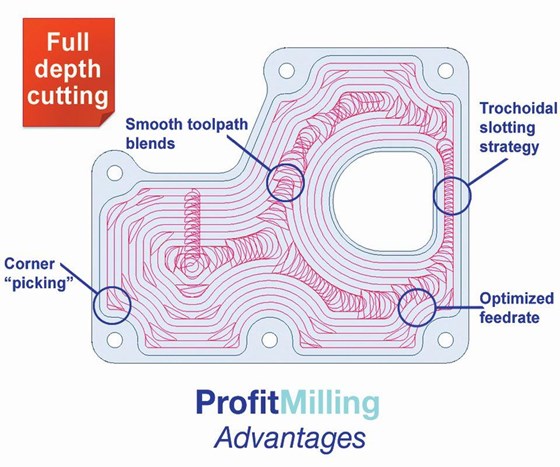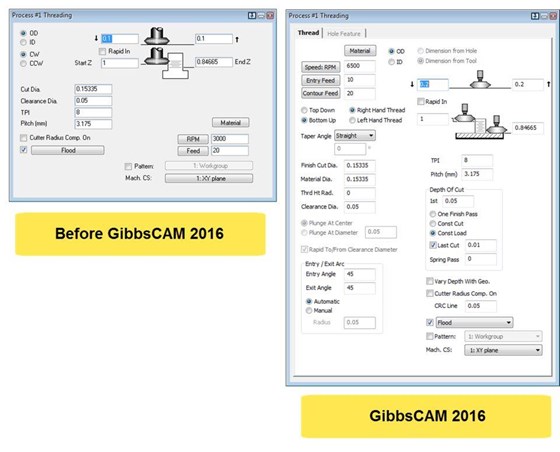
The new Max Trochoidal Width parameter in Esprit 2016’s ProfitMilling strategy allows passes to vary from wide to narrow, which lets machinists generate trochoidal movements for any size or shape pocket.

The New Hole Recognition feature in Esprit 2016 automatically recognizes different types of holes, including partial and coaxial holes, and names them accordingly.

It also treats holes that share the same axis as a single operation.

GibbsCAM 2016 supports oriented turning, including the ability to use a single tool at multiple B orientations, reorient a toolgroup for a different spindle, and turn at arbitrary orientations on machines with redundant rotary axes (see next image).


This side-by-side comparison of dialog boxes in GibbsCAM show some of 2016’s new thread milling capabilities, including varying depth with geometry, automatically recognizing hole features, basing the number of Z passes for a thread’s start and end Z on the tool’s flute length, specifying details regarding multiple passes and spring passes, and whether to rapid or feed from the center to the clearance diameter.
Previous
Next
Related:
Digital Domain
Related Suppliers
-
DP Technology
-
Mastercam/CNC Software, Inc.
Manufacturing software, specifically computer-aided manufacturing (CAM) software, continues to make advances in facilitating metal removal, tool placement, data exchange, repairing imported solids models and so much more. Here are three CAM packages with new versions in 2016.
Mastercam’s new look, for starters
Mastercam 2016 from CNC Software, Inc. (mastercam.com) sports the ribbon design interface found in Microsoft Office Suite. Some people “absolutely hate†the ribbon interface—even people within CNC Software—comments Ben Mund, senior market analyst for CNC Software. However, it’s considered “modern†and it “places the most popular Mastercam functions at your fingertips,†says Meghan Summers West, president of CNC Software. “It’s one of those things you almost don’t realize that’s changed until you go back to using older versions of Mastercam.â€
Why the change? First, the workforce is changing. Older machinists are retiring; younger ones are being hired. Second, the ribbon reduces software complexity and improves the program’s usefulness. Individual tabs within groups of functions ensure that machinists see only the functions they need—when they need it. “A lot of very low-use functions†that many customers never saw or used, explains Mund, get discovered that way.
As for machining, Mastercam has a new option for programming rough lathe toolpaths. Machinists can specify when chip breaks should occur based on length of cut or time in cut. A small jog in the toolpath is made to cause the break. Such control “is valuable when working with stringy materials, such as aluminum or plastic, which can gum up the fixturing or the tool itself,†says Mund. “You wind up with lot shorter Slinkys.â€
Dynamic milling toolpaths now follow line-of-sight through unobstructed areas. This approach results in more-efficient and less-complex repositioning during micro lifting, shorter travel distances, less motion, smaller NC file sizes and improved machining cycle times.
For multiaxis work, machinists can specify an Angle Step value instead of working with the default 2°. New features in multiaxis drilling include using a line length for drill depth, associating to selected geometry, making geometry invisible, recognizing stock model depths, selecting holes using hole-axis functionality, and linking values relative to selected points, lines or holes. A new rotary 4-axis toolpath gives machinists more control over tool motion by letting them select walls, hubs and shroud surfaces after defining the stock, selecting part geometry, setting collision control options and adjusting linking moves complex parts.
Esprit 2016 adds a new cutting strategy and more
A notable new feature in Esprit 2016 from DP Technology Corp. (espritcam.com) is a high-speed cutting strategy well suited to cutting hard materials, such as titanium and Inconel. Called “ProfitTurning,†the strategy goes beyond considering only part geometry when generating a toolpath. It considers part and tool material and shape, speeds and feeds, chip deforming and load, and machine tool power, acceleration and deceleration. This strategy, says Ivan Krstic, DP Technology’s R&D director of product engineering, yields “more efficient cuts with consistent chip loads and cutting forces, thereby reducing tool wear and increasing tool life.†The company estimates ProfitTurning can halve cutting cycle times compared to traditional cutting methods.
Barrel-shaped cutters, says Krstic, “provide a much better surface finish than ball end mills because their geometry provides a larger effective radius of engagement, resulting in smaller cusps between toolpaths.†To accommodate these cutters, the Esprit 2016 barrel tool includes 5-axis spiral roughing and finishing, port finishing, composite milling, and contouring, 3-axis Z-level roughing and finishing, parallel planes finishing, and floor finishing.
Last, in the never-ending quest to clean up imported model geometry before generating toolpaths, Esprit has various tools to correct minor defects in a CAD model. One tool smooths and heals micro defects on imported surfaces. Another tool for editing or removing fillets lets machinists extract a spine curve from fillets as a tool drive curve in machining operations. A third tool automatically recognizes different types of complex holes and names them accordingly.
GibbsCAM 2016 covers many bases
Last year’s GibbsCAM introduced Universal Kinematic Machine (UKM). That feature, says Daniel Remenak, product manager, GibbsCAM Software, for 3D Systems (3DSystems.com), “basically allowed GibbsCAM to track machine kinematics to simulate and post parts on various kinds of machines,†even machines not invented yet. Flash forward a year. GibbsCAM 2016 “knows†how a turning insert is interacting with the part—independent of machine kinematics—“oriented turning†lets the machinist tell GibbsCAM how the insert should interact with a workpiece, and then GibbsCAM automatically moves the machine to make that happen.
Oriented turning makes certain mill turn centers easier to program, particularly ones with a redundant B-axis (such as tool spindle and turret). Moreover, explains Remenak, “at any time, you can change the orientation of the part on the program’s spindle, and GibbsCAM will adapt the rest of the cutting program to that change.†GibbsCAM can also automatically handle the tool reorientation for the opposite spindle on twin-spindle machines. Another benefit is that flash tooling can be managed; machinists tell GibbsCAM what insert to use, what part is being cut, and because GibbsCAM already knows where the turning plane has to be, it’ll automatically rotate the tooling as required.
GibbsCAM 2016 also supports multi-tool thread mills, automatic taper calculation, automatic multitask (including constant load), and additional options for entries and exits, and for controlling certain moves during fast feeds. The thread milling in GibbsCAM is now aware of hole features, which reduces chunks of time in multi-process thread milling (e.g., a through-hole followed by a counter bore for the threading). Machinists no longer have to calculate the maximum engagement depth of the tool or where the taper needs to start on the second pass. After setup, all of this and more are automatically calculated, even for holes with different counter bore sizes and depths.
Particularly relevant to automotive, a new checkbox for 5-axis port machining (“roll over edgeâ€) ensures that the tool approach and entrance is smooth and gradual. For machining intake and exhaust ports on cylinder heads, for instance, this feature eliminates an entire step in post-processing, whether it be blasting or some other method of deburring sharp edges along a port.
Here’s another new feature in GibbsCAM 2016: It can import product and manufacturing information (PMI) from CAD systems, including exact color, shape and positioning of geometric dimensioning and tolerancing (GD&T) information, datums and roughness. This import saves the machinist from using an external view or referring to a PDF document for this information; it’s now displayed on the screen while programming the toolpath. Â








